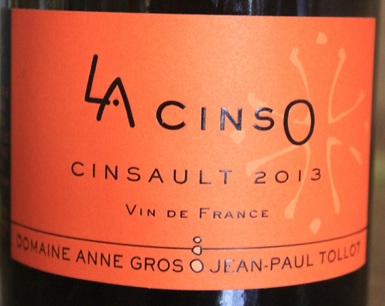
La CinsO 2013, a wine from Domaine Anne Gros (& Jean-Paul Tollot), is a deep, interesting cinsault. This wine is "grapey" at first taste with nice acidity and well-mannered tannins under the surface. I say "well mannered" because some tannins walk up and punch you right in the privates. These are there and they seem to build as you keep tasting but it is never a "rude" taste sensation. This wine opens up with some air but it really doesn’t need much. It gets more herbal a and perhaps with a bit of smoke or tar. Air adds to the nuance adding to the the notion this is a wine to think on. Try to catalog the various herbal sensations.
There is dark fruit here but it is subtle and a bit elegant. There is nothing jammy here and yet CinsO isn't all subtlety. I wrote "grapey" but other dark fruits are probably more prevalent--blackberries and blueberries spring to mind. There are deep textured flavors that seem almost inorganic but I wouldn’t say "minerally." This may be getting too esoteric. CinsO isn't all THAT deep and complicated but it may be more than might be expected for a grape often used in blends and for rosés.
La CinsO comes from Minervois in Languedoc-Roussillon but the winemakers are best known for their burgundies. Cinsault is not a "rare" grape but it isn't one on the tip of the tongue for many wine fans. The varietal often finds its way into rosés and red cinsault I've tasted have frequently been light, summery reds. As noted this one has a bit more to it.
Anne Gros and John Paul Tollot are the winemakers here and both are most well known for their Burgundies. While I didn't think "Burgundy" when I drank this I also didn't think "Languedoc" but my experience with 100 percent cinsault from the area is, to put it mildly, limited.
Cinsault isn't a rare grape. It is widely grown in France, North Africa and a number of other areas (including some quite old vines in Northern California). You do not, however, see a great deal of it bottled as a varietal and often these are everyday wines. At $20 a bottle-ish most people won't think this wine is an everyday price but it is also a notch up other cinsault.
This wine is labelled as a “Vin de France,” a table wine but that label can be deceptive. Sometimes it isn't about quality but about the winemaker not following the regional rules. This wine also reminds that however modest the grape to wine experts; land and climate (terroir) and careful handling of yields (the fewer grapes per vine, the higher the quality) can lead to a solid, interesting wine. This isn't something that will shatter your world but it is a wine that is a bit different, with a little bit our roughness, a tiny bit of funkiness (early Commodores...not Parliament) and also something you can use to stump your friends; no one will say "Minervois cinsault" at your blind tasting!
 RSS Feed
RSS Feed